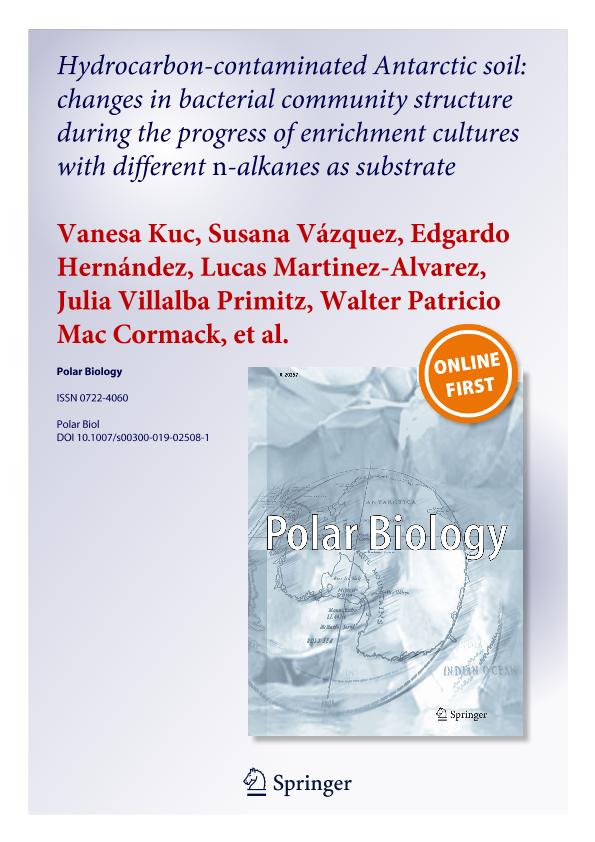Artículo
Hydrocarbon-contaminated Antarctic soil: changes in bacterial community structure during the progress of enrichment cultures with different n-alkanes as substrate
Kuc, Vanesa; Vázquez, Susana Claudia ; Hernández, Edgardo; Martinez Alvarez, Lucas Manuel
; Hernández, Edgardo; Martinez Alvarez, Lucas Manuel ; Villalba Primitz, Julia Elena Rosina
; Villalba Primitz, Julia Elena Rosina ; Mac Cormack, Walter Patricio; Ruberto, Lucas Adolfo Mauro
; Mac Cormack, Walter Patricio; Ruberto, Lucas Adolfo Mauro
 ; Hernández, Edgardo; Martinez Alvarez, Lucas Manuel
; Hernández, Edgardo; Martinez Alvarez, Lucas Manuel ; Villalba Primitz, Julia Elena Rosina
; Villalba Primitz, Julia Elena Rosina ; Mac Cormack, Walter Patricio; Ruberto, Lucas Adolfo Mauro
; Mac Cormack, Walter Patricio; Ruberto, Lucas Adolfo Mauro
Fecha de publicación:
05/2019
Editorial:
Springer
Revista:
Polar Biology
ISSN:
0722-4060
e-ISSN:
1432-2056
Idioma:
Inglés
Tipo de recurso:
Artículo publicado
Clasificación temática:
Resumen
Hydrocarboncontamination in soils from extremely cold areas, such as those from Antarctica,requires the development of specifc remediation strategies for cleaning up anthropogenicpollution. Previous reports evidenced that after on-site biostimulation processof gasoil-contaminated Antarctic soils, 20% of the initial hydrocarbons remainedundegraded (mainly C11?C14 n-alkanes). In the present work, these n-alkanes wereadded as sole carbon and energy source to enrichment cultures inoculated with thepreviously treated soil (biostimulation) as microorganism?s source to investigatechanges occurring in the bacterial community structure. Three subcultures (8, 16,and 24fdays) were performed from each enrichment culture. Changes in bacterial communitiesamong dilerent cultures and its subcultures were evidenced by Denaturing GradientGel Electrophoresis (DGGE). Results showed that even dilerences of one C in thealkane chain-length led to dilerent community structures that evolved divergentlyfrom the original one. Clusters analysis showed that while samples grouped mainlyby culture time, substrate-dependent dilerences were also evident. Isolation ofbiological tools for bioremediation from the cultures showed that Pseudomonadaceaemembers were omnipresent, whereas Rhodococcus spp. were obtained in cultures withthe longest chain-length substrates. Results provided evidence about the presenceof certain substrate preference of soil bacteria (even when substrates dilered onlyin one C-atom of their chain-length), leading to dilerent community structures.A collection of psychrotolerant hydrocarbon degrading/tolerant strains was obtained,representing a valuable tool for the design of a bioaugmentation strategy as a second,more specifc stage, targeting the remnant hydrocarbons after a frst bioremediationprocess involving biostimulation.
Archivos asociados
Licencia
Identificadores
Colecciones
Articulos(NANOBIOTEC)
Articulos de INSTITUTO DE NANOBIOTECNOLOGIA
Articulos de INSTITUTO DE NANOBIOTECNOLOGIA
Citación
Kuc, Vanesa; Vázquez, Susana Claudia; Hernández, Edgardo; Martinez Alvarez, Lucas Manuel; Villalba Primitz, Julia Elena Rosina; et al.; Hydrocarbon-contaminated Antarctic soil: changes in bacterial community structure during the progress of enrichment cultures with different n-alkanes as substrate; Springer; Polar Biology; 42; 6; 5-2019; 1157-1166
Compartir
Altmétricas



